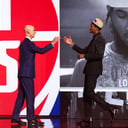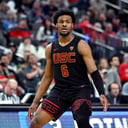SALT LAKE CITY — The Utah Jazz were hoping there would be one. In neither world did they anticipate that the other would be available. Put the two together and the Jazz had one of the best first-round drafts in the NBA.
Utah used its lottery pick, the 10th pick, on Colorado forward Cody Williams, one of the players in Wednesday’s draft who has significant potential. The Jazz used their second first-round pick on USC point guard Isaiah Collier, who was once tipped to be selected in the lottery. And even though his value regressed during the draft process, he was still expected to rank somewhere in the top 20.
With the Jazz in the midst of a rebuild, the draft has been an important tool they have used. In the days ahead, expect Utah to explore ways to improve a roster that finished near the bottom of the Western Conference. But the draft is the only thing the Jazz have control over, and on Wednesday, Utah came away with as good a draft as they could have hoped for on paper.

GO FURTHER
Winners and losers of the first round of the 2024 NBA draft: Jazz, Wizards and Lakers on top
We examine why below, including a prediction for Thursday afternoon’s second round, in which Utah is closing in on the top. With the Jazz stockpiling young talent, how does it all play out? And what will Utah do next?
Divine intervention?
If the Jazz had gotten lucky and won the lottery, Williams would have been firmly in the mix to be the No. 1 pick. In the end, he may not, or even probably won’t, get the green light. But the fact that he was reportedly considered should tell you how interested the Jazz were in the small forward. They did a ton of preliminary homework on him. They interviewed him at the NBA Draft Combine. They brought him in for private training. Jazz general manager Justin Zanik and head coach Will Hardy took him out to dinner.
As much as the physical talent and upside, the Jazz were considerably impressed by the maturity Williams showed throughout the process. Those are some of the reasons Williams rose to the top of Utah’s selection committee. The Jazz entered the draft thinking maybe they should move up to draft him. It turned out they didn’t need to go anywhere
A few elements allowed them to choose their preferred choice. The Detroit Pistons selected athletic small forward Ron Holland with the No. 5 pick, which pushed UConn center Donovan Clingan further down the rankings. At No. 8, the Minnesota Timberwolves jumped into the top 10 to take Kentucky point guard Rob Dillingham. Once that happened, the Memphis Grizzlies nabbed Purdue big man Zach Edey with the ninth pick.
“When we spoke on Monday, I said this draft was going to be unpredictable,” Zanik said. “There were a number of things and a number of scenarios. We tried to get as much in place as possible before the draft in terms of models and where players were projected. We have received many calls to trade up or down. But our modeling told us to stay put, and we’re thrilled with how the draft went.
The Jazz know they have a lot of work to do with Williams. It must add a lot of strength. Williams needs to learn to be more assertive when he’s on the court. But when you look at the 6-foot-8 frame, length and skill set, it’s easy to see why the Jazz and others were intrigued.
In the words of Cody Williams, “look good, feel good” 💜🎵 pic.twitter.com/k7Pny96uL7
-Utah Jazz (@utahjazz) June 27, 2024
The hope is that Williams’ development mirrors or closely resembles the development of his older brother Jalen Williams, who established himself as a star with the Oklahoma City Thunder. In terms of fit, the Jazz are great for Williams. Utah doesn’t have a natural small forward on its roster, which means Williams gives the Jazz exactly one natural small forward on the roster. Beyond that, Williams is a good shooter, he can play off the dribble, and he can pass and defend.
Jazz leaders Danny Ainge and Zanik have long had coveted size and length at the post. Williams needs to work on size and strength. But length and athleticism both check the boxes needed for the Jazz.
“He’s a true power forward with speed, talent and NBA skills,” Zanik said Wednesday night. “He is very young and he needs to work on his body. But he is very mature for his age. It is very easy to see the talent and athletic skills he possesses.
What we know
Collier has flaws in his game.
He doesn’t play without the basketball in his hands and he doesn’t move without the ball. He should be a better defender because of his size, strength and athleticism. His jump shot is uneven. He has had turnover problems in the past.
But he’s a dynamic talent. He and Rob Dillingham are probably the two best guards in the draft at coming off the dribble. He’s a fantastic passer. Collier lives in the dribble lane and creates significant rim pressure for opposing defenses. He’s a tremendous competitor who doesn’t back down from his opponents, and frankly, the Jazz need more of that.
The flaws are numerous, and how Collier overcomes them will tell us how his NBA career will play out. But there’s no reason for a player of his overall talent level to be on the board at 29th. The Jazz metaphorically sprinted to the podium to take it, flaws and all. Collier likely instantly becomes Utah’s best and most dynamic passer, which may well be an indictment of the roster in its current form.
Expect the Jazz to continue attempting to bolster the free agent roster, simply because the roster can’t be filled with kids. And if that happens in the backcourt, you can expect Collier to spend a good portion of his time either in the G League or able to learn his trade at the NBA level. But there is no denying that the Jazz made one of the best picks of the first round.
Collier was arguably the best high school basketball player in the country two years ago. He entered this season as a top-10 pick. Part of his first-round fall was self-inflicted, particularly because scouts were a little discouraged by the lack of defense early in the college season. And then he got injured. And then, USC struggled.
But Collier has a chance to thrive in the spacing the NBA provides. He’s going to have the opportunity to prove a lot of people wrong.
“You know how much we love to play,” Zanik said. “(Hardy) says move the ball. Isaiah moves the ball, as does Cody. Having two guys who have the ability to connect is important. They have physical and technical profiles that can match the NBA.
And after
In the days and weeks leading up to the draft, the prevailing sentiment was that Utah didn’t want to use its three picks because the Jazz already had three rising second-year players and there was only so much youth to fit on the roster.
But there is so much value and so many good players still available heading into Thursday’s second round that the Jazz are excited to use the No. 32 pick. There’s Kyle Filipowski from Duke. There’s Tyler Kolek from Marquette. There’s Tyler Smith, the big man from G League Ignite. There’s Johnny Furphy from Kansas. These are four players who had marks in the first round and who are all still available.

GO FURTHER
2024 NBA Second Round Mock Draft: What to Look for on Day 2, Including Bronny James
Utah will still explore trade scenarios, perhaps considering moving down and picking up a few more assets. But with so much talent remaining on the board, the Jazz are happy with the position they find themselves in.
(Photo by Isaïe Collier: Wally Skalij / Getty Images)